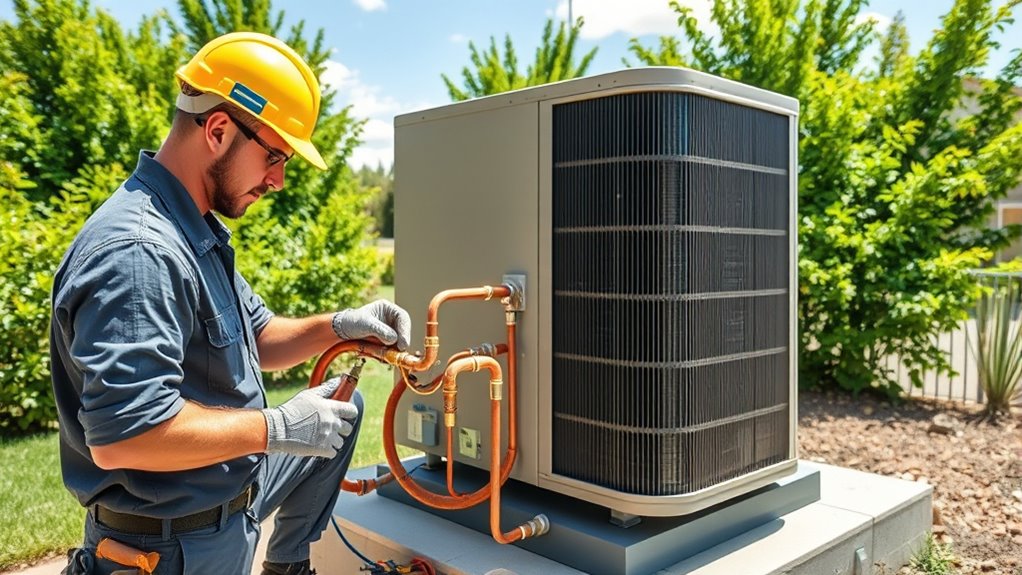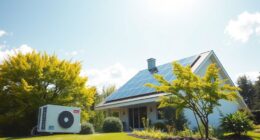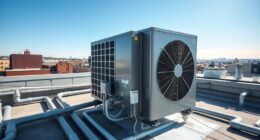To install a heat pump, start by selecting a unit suited for your home and climate, then choose a good outdoor spot with enough airflow. Mount the outdoor unit securely on a level pad, connect refrigerant lines, electrical wiring, and drainage, and hire professionals for electrical work. Program your thermostat, test the system thoroughly, and perform regular maintenance for efficiency. Continue following proper steps to guarantee a smooth installation and long-term savings.
Key Takeaways
- Select a suitable heat pump and ensure proper sizing for your home and climate.
- Choose a shaded outdoor location with good airflow, and prepare a stable mounting platform.
- Connect refrigerant lines, electrical wiring, and condensate drain securely, preferably with professional assistance.
- Program the thermostat, test the system thoroughly, and verify proper operation for efficiency.
- Perform regular maintenance like filter cleaning and duct inspection to maintain optimal performance.

Installing a heat pump can be a straightforward process when you follow the right steps. The first thing you want to consider is choosing a unit that suits your home’s size and your climate. Once you’ve selected the right model, you’ll need to assess your property’s existing HVAC system, ensuring compatibility and determining if any upgrades are necessary. Proper installation is crucial because it directly impacts the system’s energy efficiency and overall performance. An efficient heat pump consumes less electricity, saving you money in the long run, so it’s worth investing in a quality unit and professional installation.
Choosing the right heat pump and professional installation ensures optimal energy efficiency and long-term savings.
Next, you’ll need to prepare the installation site. This involves selecting an appropriate outdoor location, ideally shaded and away from obstructions, to maximize efficiency. Good airflow around the unit enhances performance and reduces strain on the system. If you’re installing a ductless mini-split, the process is simpler because it requires less space and fewer modifications. For traditional ducted systems, you might need to inspect and repair or replace existing ductwork to prevent air leaks and improve energy efficiency. Properly sealed and insulated ducts lower your energy bills and ensure your heat pump operates as efficiently as possible.
The actual installation process involves mounting the outdoor unit, usually on a concrete pad or a sturdy, level platform. Then, you’ll connect the refrigerant lines, electrical wiring, and condensate drain. Ensuring tight, secure connections is essential to prevent leaks and electrical issues. If you’re not experienced with electrical work, hiring a professional is highly recommended, as improper wiring can lead to safety hazards and increased installation costs. Once everything is connected, you’ll need to program the thermostat and test the system thoroughly. This step confirms that the heat pump is functioning correctly and efficiently, providing reliable heating and cooling.
Throughout the installation, keep in mind that proper setup not only enhances energy efficiency but also reduces future maintenance costs. Regular upkeep, such as cleaning filters and inspecting components, helps your system run smoothly for years. In terms of installation costs, investing in professional help might seem like an added expense initially, but it often pays off by ensuring your system runs at peak efficiency. Poor installation can lead to higher energy bills, more frequent repairs, and a shorter lifespan for your heat pump. So, while the upfront costs might seem higher, the long-term savings and comfort are well worth the investment. By following these steps carefully and prioritizing quality installation, you’ll enjoy a more energy-efficient and cost-effective heating and cooling solution for your home.
Frequently Asked Questions
What Is the Typical Lifespan of a Heat Pump?
A heat pump typically lasts 10 to 15 years, depending on usage and maintenance. During this time, it maintains energy efficiency, helping you save on energy bills and reduce environmental impact. Regular upkeep ensures peak performance and extends its lifespan. Keep an eye on potential signs of wear, and prompt repairs can help you enjoy its benefits longer. Proper maintenance and timely upgrades are key to maximizing your heat pump’s longevity.
How Much Does Professional Installation Usually Cost?
Cost comparison can be tricky, but professional installation typically costs between $4,000 and $8,000. You’ll want to think about the installation process, which includes site assessment, system setup, and testing. Skilled specialists handle these steps swiftly, ensuring efficiency and safety. While the price may seem steep, investing in expert installation guarantees ideal performance, longevity, and energy savings, making it a worthwhile, wise expenditure for your warm, worry-free home.
Are Heat Pumps Suitable for Extreme Cold Climates?
Yes, heat pumps can be suitable for extreme cold climates, especially modern models designed for climate adaptability. They maintain energy efficiency even when temperatures drop markedly, providing reliable heating. Look for cold climate heat pumps with advanced technology like variable-speed compressors and enhanced defrost systems. These features guarantee you stay warm without sacrificing efficiency, making them a smart choice for colder regions.
What Maintenance Is Required After Installation?
After installation, you should regularly check your heat pump’s system efficiency and refrigerant levels to keep it running smoothly. Clean or replace filters monthly, especially during peak use, and clear debris around outdoor units. Schedule annual professional inspections to ensure refrigerant levels stay ideal and components are functioning correctly. Proper maintenance helps your heat pump operate efficiently, saves energy, and extends its lifespan.
Can I Install a Heat Pump Myself?
Don’t bite off more than you can chew—installing a heat pump yourself isn’t recommended. While DIY concerns might tempt you to try, installation risks like improper setup can lead to costly damage or safety hazards. Unless you have technical skills and experience, it’s best to call in a professional. Remember, a job done right saves you money and stress in the long run.
Conclusion
Installing a heat pump is a smart way to boost your home’s energy efficiency. Did you know that heat pumps can reduce energy bills by up to 50%? By following this step-by-step guide, you’re making a sustainable choice that saves money and benefits the environment. Take your time, stay safe, and enjoy the comfort of an upgraded, eco-friendly heating and cooling system. Your efforts will pay off with long-term savings and increased home value.








